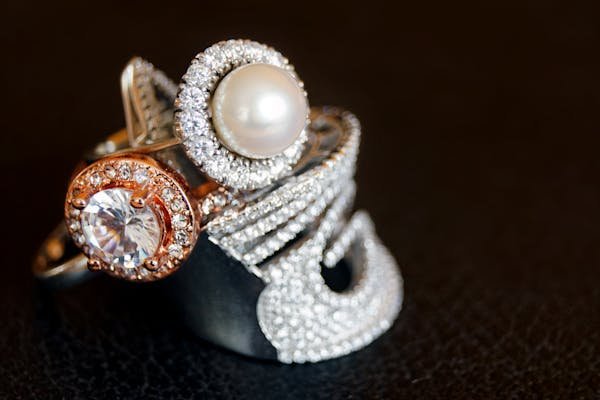Starting a jewelry business is an exciting venture. You get to create beautiful pieces that people will cherish for years. But to turn your passion into a successful business, you need to market your jewelry effectively. Without the right marketing strategies, potential customers might never discover your stunning creations. This guide will walk you through detailed, actionable steps to market your jewelry business and attract more customers.
Understanding Your Market
Deep Dive into Customer Demographics
Understanding your market begins with a thorough analysis of your customer demographics. As a jewelry business owner, you need to gather detailed information about your customers’ age, gender, income levels, geographic location, and lifestyle.
This data will help you create highly targeted marketing campaigns. For instance, if you discover that a significant portion of your customers are young professionals living in urban areas, you can focus your marketing efforts on trendy, modern jewelry pieces that appeal to their tastes and budgets.
Analyzing Psychographics
While demographics tell you who your customers are, psychographics delve into their behaviors, attitudes, and interests. Psychographic information includes values, hobbies, spending habits, and lifestyle choices. To gather this data, conduct surveys, engage with your customers on social media, and analyze their online behavior.
For example, if your target audience values sustainability, you can emphasize eco-friendly materials and ethical sourcing in your marketing messages. Understanding what motivates your customers will allow you to connect with them on a deeper level and tailor your offerings to meet their specific needs.
Competitive Analysis
Analyzing your competitors is a crucial step in understanding your market. Identify the key players in the jewelry industry and study their marketing strategies, product offerings, pricing, and customer service. Look for gaps in the market that you can fill.
For instance, if you notice that your competitors are not offering customizable jewelry, you can introduce a range of personalized options to attract customers seeking unique pieces. Understanding what your competitors are doing well and where they are lacking can help you position your business more effectively.
Market Trends and Demand
Keeping up with market trends is essential for staying relevant in the jewelry industry. Research current trends in jewelry design, materials, and customer preferences. Use tools like Google Trends, industry reports, and social media platforms to track emerging trends.
For instance, if there’s a growing demand for minimalist jewelry, consider adding a minimalist collection to your product line. Being aware of market trends allows you to anticipate customer needs and stay ahead of the competition.
Identifying Market Segments
Segmenting your market involves dividing your broad customer base into smaller, more manageable groups based on specific criteria such as demographics, psychographics, and buying behavior. Each segment should have distinct characteristics that require different marketing approaches.
For example, you might have one segment of young brides looking for bridal jewelry and another of middle-aged professionals seeking everyday wear pieces. By creating targeted marketing strategies for each segment, you can increase the relevance of your messages and improve conversion rates.
Creating Buyer Personas
Buyer personas are semi-fictional representations of your ideal customers based on market research and real data. Creating detailed buyer personas helps you understand your customers’ needs, preferences, and pain points.
For instance, a buyer persona for your bridal jewelry line might be “Emily,” a 28-year-old bride-to-be who is looking for elegant, timeless pieces for her wedding day. Include details such as her job, hobbies, preferred shopping channels, and budget. Use these personas to guide your marketing efforts and ensure that your campaigns resonate with your target audience.
Customer Journey Mapping
Understanding the customer journey is essential for optimizing your marketing strategies. Map out the various stages your customers go through, from awareness to purchase and post-purchase. Identify the touchpoints where customers interact with your brand and the key decisions they make along the way.
For example, the journey for a customer purchasing an engagement ring might start with online research, followed by visiting your website, reading reviews, and finally making a purchase in-store or online. By understanding this journey, you can create targeted content and marketing messages that guide customers smoothly through the process.
Leveraging Technology for Market Research
Technology can significantly enhance your market research efforts. Use analytics tools like Google Analytics to track website traffic, user behavior, and conversion rates. Social media analytics can provide insights into your audience’s preferences and engagement levels.
Customer relationship management (CRM) software can help you gather and analyze customer data, allowing you to personalize your marketing efforts. Leveraging these tools can provide you with a wealth of data to make informed decisions about your marketing strategies.
Engaging with Your Audience
Engaging directly with your audience can provide invaluable insights into their preferences and expectations. Use social media platforms to interact with your customers, ask for feedback, and participate in conversations about jewelry trends and fashion.
Hosting Q&A sessions, live videos, and interactive polls can help you gather real-time data and build stronger relationships with your customers. Customer engagement not only provides market insights but also enhances customer loyalty and brand trust.
Building a Strong Brand

Define Your Brand’s Mission and Values
Your brand’s mission and values are the foundation of your business. They define what you stand for and guide your decision-making process. Start by clearly articulating your brand’s mission. Why does your business exist? What impact do you want to make in the jewelry industry?
Your mission statement should be concise, memorable, and reflective of your core values. For example, if sustainability is important to you, emphasize eco-friendly practices and ethical sourcing in your mission. These values should be evident in every aspect of your business, from product design to customer service.
Develop a Unique Brand Voice
Your brand voice is how you communicate with your audience, and it should be consistent across all platforms. It reflects your brand’s personality and helps build a connection with your customers. Think about how you want your brand to be perceived.
Do you want to be seen as luxurious and sophisticated, or fun and approachable? Once you’ve defined your brand voice, use it consistently in your website content, social media posts, email newsletters, and advertising. This consistency helps build brand recognition and trust.
Create a Visually Cohesive Brand
A visually cohesive brand ensures that all your marketing materials look and feel like they belong together. This includes your logo, color palette, typography, and imagery. Invest in professional design services to create a logo that represents your brand’s essence.
Choose colors that evoke the right emotions and complement your jewelry pieces. Consistent typography across your website, social media, and printed materials enhances the professional look of your brand. High-quality imagery is also crucial. Use professional photos and videos to showcase your products, ensuring they reflect your brand’s style and quality.
Establish Brand Guidelines
Brand guidelines are a set of rules that define how your brand should be represented visually and verbally. They ensure consistency across all marketing channels and help maintain the integrity of your brand. Your brand guidelines should include details on your logo usage, color palette, typography, imagery style, and brand voice.
Share these guidelines with anyone who creates content for your brand, including employees, freelancers, and partners. Consistent application of your brand guidelines builds a strong, recognizable brand identity.
Leverage Storytelling in Your Branding
Storytelling is a powerful tool for building a strong brand. Share the story behind your jewelry business, including your inspiration, challenges, and achievements. Stories humanize your brand and make it more relatable to your audience. Use storytelling in your website content, social media posts, and marketing materials.
Highlight the craftsmanship and thought process behind each piece of jewelry. Share customer stories and testimonials to showcase real-life experiences with your products. Storytelling creates an emotional connection with your audience, fostering loyalty and trust.
Build Emotional Connections with Customers
Building emotional connections with your customers is essential for brand loyalty. Show that you genuinely care about their needs and experiences. Personalize your interactions with customers by using their names and remembering their preferences.
Offer exceptional customer service by promptly addressing inquiries and resolving issues. Celebrate milestones with your customers, such as birthdays or anniversaries, by sending personalized messages or exclusive offers. When customers feel valued and appreciated, they are more likely to remain loyal to your brand.
Emphasize Unique Selling Propositions (USPs)
Your unique selling propositions (USPs) differentiate your jewelry brand from competitors. Identify what makes your jewelry special and highlight these features in your marketing efforts. Your USPs could be your use of rare materials, customizable designs, or a commitment to sustainability.
Clearly communicate these benefits to your customers in your product descriptions, website content, and advertising. Emphasizing your USPs helps potential customers understand why they should choose your brand over others.
Engage in Community Building
Building a community around your brand enhances customer loyalty and brand advocacy. Create opportunities for your customers to connect with each other and with your brand. Host events, both online and offline, where customers can learn about jewelry care, design their own pieces, or simply meet others who share their passion for jewelry.
Use social media to foster community engagement by encouraging customers to share their experiences and interact with your brand. A strong community not only increases customer retention but also generates word-of-mouth referrals.
Monitor and Adapt Your Brand Strategy
Building a strong brand is an ongoing process that requires regular monitoring and adaptation. Use analytics tools to track the performance of your branding efforts, such as website traffic, social media engagement, and customer feedback.
Identify areas where your brand can improve and make necessary adjustments. Stay updated with industry trends and customer preferences to keep your brand relevant. Being flexible and responsive to changes ensures that your brand continues to resonate with your audience.
Invest in Professional Development
As a founder, investing in your professional development can enhance your brand. Stay informed about the latest trends in jewelry design, marketing, and business management. Attend industry conferences, participate in workshops, and seek mentorship from experienced professionals.
Continuous learning and improvement reflect positively on your brand and demonstrate your commitment to excellence. Share your knowledge and experiences with your audience to position yourself as an expert in the jewelry industry.
Leveraging Online Platforms
Optimizing Your Website for Conversions
Your website is often the first point of contact between your brand and potential customers, so optimizing it for conversions is crucial. Ensure your website is easy to navigate, with clear categories for different types of jewelry. The checkout process should be seamless and straightforward to reduce cart abandonment rates.
Use high-quality images and detailed descriptions to showcase your jewelry, and include a zoom feature so customers can see the details up close. Implement trust signals such as customer reviews, testimonials, and security badges to build credibility.
Enhancing User Experience
A great user experience can significantly impact how potential customers perceive your brand. Make sure your website is fast, responsive, and mobile-friendly, as many users will be shopping from their phones. Simplify the search functionality by allowing filters for price, material, style, and other attributes.
Provide an option for customers to create accounts, which can store their preferences and past orders for a more personalized shopping experience. Offering a live chat feature can also help address customer queries in real-time, improving overall satisfaction and increasing the likelihood of a purchase.
Utilizing Search Engine Marketing (SEM)
Search Engine Marketing (SEM) is an effective way to drive traffic to your website through paid advertising. Platforms like Google Ads allow you to bid on keywords related to your products so your ads appear in search results when potential customers look for jewelry.
Create compelling ad copy that highlights your unique selling propositions and includes a clear call-to-action. Use Google’s Shopping Ads to display your products directly in search results, complete with images, prices, and your store’s name. Continuously monitor your ad performance and adjust your bids and keywords to maximize your return on investment.
Social Media Advertising
Social media advertising can help you reach a larger audience and generate more sales. Platforms like Facebook, Instagram, and Pinterest offer robust advertising options that allow you to target users based on demographics, interests, and behaviors.
Create visually appealing ads that showcase your jewelry in various settings and contexts. Use carousel ads to display multiple products, and consider running video ads to capture attention and tell a story. Regularly analyze the performance of your ads and refine your targeting and creative strategies to improve results.

Related: Check out our free tools:

Influencer Partnerships
Partnering with influencers can significantly expand your reach and credibility. Choose influencers who align with your brand values and have a following that matches your target audience. Collaborate with them to create authentic content that features your jewelry.
This could be in the form of unboxing videos, styling tutorials, or photos of them wearing your pieces. Influencers can also host giveaways or special promotions to drive engagement and sales. Track the results of these partnerships to understand their impact and refine your approach for future collaborations.
Content Marketing
Content marketing involves creating valuable and engaging content to attract and retain customers. Start a blog on your website where you share jewelry care tips, style guides, behind-the-scenes looks at your design process, and stories about the inspiration behind your collections.
High-quality content can improve your search engine rankings, drive traffic to your site, and position you as an expert in the jewelry industry. Additionally, consider creating downloadable resources such as e-books or style guides that provide even more value to your customers.
Email Marketing Campaigns
Email marketing remains one of the most effective ways to nurture leads and drive repeat business. Segment your email list based on customer behavior, preferences, and purchase history to send targeted campaigns. Regularly send newsletters that include new product launches, exclusive offers, and personalized recommendations.
Use automation to send timely emails such as welcome messages to new subscribers, reminders for abandoned carts, and thank-you notes after a purchase. Personalize your emails to make them more engaging and increase the likelihood of conversion.
Engaging with Customers on Social Media
Active engagement on social media can help you build a loyal community around your brand. Respond to comments and messages promptly, and engage with your followers by liking and commenting on their posts. Use interactive features like polls, Q&A sessions, and live videos to foster a two-way conversation.
Share user-generated content to show appreciation for your customers and build social proof. Hosting regular giveaways or contests can also boost engagement and attract new followers.
Leveraging Analytics and Data
Utilize analytics tools to track the performance of your online marketing efforts. Google Analytics can provide insights into your website traffic, user behavior, and conversion rates. Social media platforms offer their own analytics that show engagement metrics, reach, and audience demographics.
Regularly review this data to understand what’s working and what isn’t. Use these insights to make data-driven decisions and continuously improve your marketing strategies. Setting up conversion tracking for your ads can also help you measure the return on investment and optimize your campaigns for better results.
Integrating E-commerce Platforms
If you sell your jewelry on multiple e-commerce platforms like Etsy, Amazon, or Shopify, ensure they are integrated seamlessly with your website and marketing strategies. Use tools that allow you to manage inventory, orders, and customer data across all platforms from a single dashboard.
This integration can save time and reduce errors, providing a better experience for your customers. Additionally, promote your presence on these platforms through your website and social media to drive traffic and sales.
Utilizing Visual Content
Investing in Professional Photography
High-quality photography is crucial for showcasing your jewelry in the best possible light. Invest in a professional photographer who specializes in jewelry. Jewelry photography requires specific techniques to capture the intricate details and sparkle of each piece.
Work with your photographer to create a style that reflects your brand, whether it’s minimalist and modern or luxurious and opulent. Consistent, high-quality images can elevate your brand and make your online presence more compelling.
Creating a Consistent Visual Style
Consistency in your visual content helps establish a strong brand identity. Develop a visual style guide that outlines your preferred color palette, lighting, angles, and background settings for your photos.
This guide ensures that all your visual content, whether for your website, social media, or advertising, maintains a cohesive look. A consistent visual style makes your brand easily recognizable and more professional, which can build trust and appeal to potential customers.
Leveraging Lifestyle Photography
In addition to product shots, lifestyle photography can help customers visualize how your jewelry fits into their lives. Show your pieces being worn in various contexts—at a formal event, in a casual setting, or paired with different outfits.
Lifestyle images can evoke emotions and aspirations, making your jewelry more relatable and desirable. These photos are particularly effective on social media and in marketing campaigns, as they tell a story and connect with viewers on a personal level.
Utilizing Video Content
Video content is an increasingly important tool in digital marketing. Create videos that showcase your jewelry from different angles, highlight the craftsmanship, and demonstrate how to wear and style your pieces. Short, engaging videos can be used on social media, your website, and in email marketing campaigns.
Consider creating behind-the-scenes videos that give customers a glimpse into your design process and the making of your jewelry. This not only highlights the quality and uniqueness of your products but also builds a deeper connection with your audience.
Hosting Live Demonstrations
Live demonstrations can be a powerful way to engage with your audience in real time. Use platforms like Instagram Live, Facebook Live, or YouTube Live to showcase new collections, provide styling tips, and answer customer questions. Promote your live sessions in advance to build anticipation and ensure a good turnout.
During the live event, interact with viewers by addressing their comments and questions, and consider offering exclusive discounts to participants. Live demonstrations can drive immediate sales and strengthen your relationship with your audience.
Incorporating User-Generated Content
User-generated content (UGC) can enhance your brand’s credibility and authenticity. Encourage your customers to share photos and videos of themselves wearing your jewelry. Feature their content on your social media channels, website, and marketing materials.
UGC provides social proof, showing potential customers that real people love and wear your jewelry. To encourage more UGC, create a branded hashtag and run contests or campaigns that incentivize customers to share their photos.
Using 360-Degree Images
360-degree images allow customers to see your jewelry from every angle, providing a more interactive and detailed view.
Implementing 360-degree photography on your website can enhance the shopping experience and reduce uncertainty, making customers more confident in their purchase decisions. This technology can be particularly effective for high-end or intricate pieces where the details are a significant selling point.
Creating Shoppable Content
Shoppable content integrates your products directly into your visual content, making it easy for customers to purchase what they see. Platforms like Instagram and Pinterest offer features that allow you to tag products in your photos and videos.
When customers click on these tags, they are taken directly to the product page on your website. This seamless shopping experience can increase conversion rates and make your social media marketing more effective.
Optimizing Images for SEO
Optimizing your images for search engines can help drive organic traffic to your website. Use descriptive file names and alt text for all your images, incorporating relevant keywords. This helps search engines understand the content of your images and index them properly.
Optimized images can appear in image search results, increasing your visibility and attracting more potential customers to your site. Additionally, ensure your images are compressed and optimized for fast loading times, as this impacts both user experience and SEO rankings.
Telling a Story Through Visuals
Every piece of jewelry you create has a story behind it. Use your visual content to tell these stories. Whether it’s the inspiration behind a design, the materials used, or the craftsmanship involved, sharing these stories can make your jewelry more meaningful to customers.
Create a series of photos or videos that follow the journey of a piece of jewelry from concept to completion. Storytelling through visuals can captivate your audience and create a deeper emotional connection with your brand.
Using Visual Content in Email Marketing

Incorporating visual content into your email marketing can significantly boost engagement. Include high-quality images of your latest collections, styled looks, and behind-the-scenes shots.
Use videos or GIFs to add movement and interest to your emails. Ensure that your visuals are optimized for email, with appropriate file sizes and responsive design. Visually appealing emails can capture attention and drive traffic to your website.
Analyzing the Performance of Visual Content
Regularly analyze the performance of your visual content to understand what resonates with your audience. Use analytics tools to track metrics such as engagement, shares, and conversion rates.
Identify which types of visuals—whether it’s product shots, lifestyle images, or videos—perform best and adjust your strategy accordingly. Continuous analysis and optimization ensure that your visual content remains effective and aligned with your marketing goals.
Conclusion
Marketing your jewelry business effectively requires a multifaceted approach that combines understanding your market, building a strong brand, leveraging online platforms, and utilizing high-quality visual content. By deeply understanding your target audience and conducting thorough market research, you can tailor your marketing strategies to meet their needs and preferences.
Building a strong brand involves more than just creating a logo; it’s about defining your mission, developing a unique brand voice, and consistently applying your visual identity across all platforms. This helps create a cohesive and memorable brand that resonates with your customers.
Read Next:
- Festive Campaign Ideas for Christmas Marketing
- Marketing Strategies for Architecture Firms
- Catchy Name Ideas for Your Digital Marketing Company
- Top Marketing Strategies for Realtors
- Effective Marketing Strategies for Staffing Agencies






















Comments are closed.